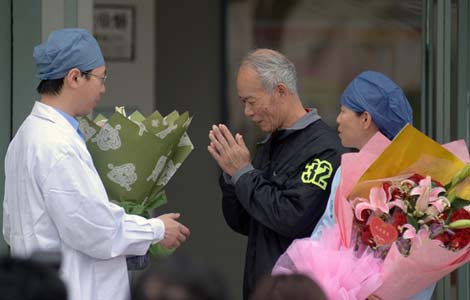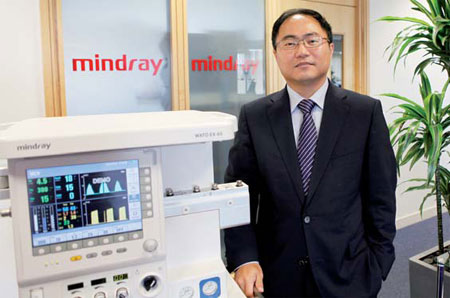In Europe for Europe
Updated: 2013-03-15 07:20
By Yan Yiqi, Cecily Liu and Zhang Chunyan (China Daily)
|
||||||||
Challenges ahead
As with any companies entering a foreign market, challenges are inevitable for Chinese companies.
Cucino says the survey respondents cited operational problems, rather than market access, as the biggest obstacle for Chinese investment in Europe.
Other big problems included obstacles in obtaining visas and work permits for Chinese employees, European labor laws, human resources costs and cultural differences in management style.
Many Chinese companies have found it difficult to employ Chinese workers at their UK subsidiaries, because the British government often rejects their applications to sponsor work permits for their employees who are non-EU nationals.
This is because the government limits the number of work permits granted to 20,700 a year. This quota is then allocated to each professional category.
If the number of applications for work permits made by companies in a particular professional category exceeds the category's quota, generally applicants with the highest salary will get the places, says Xue Haibin, a partner in the London office of Zhong Lun Law Firm.
Xue says that it has been very difficult for his company to secure work permits for employees, because the salary it offers cannot compete with that of the biggest British law firms.
|
David Yin says Mindray Medical's success in the EU and US markets has helped it win trust elsewhere. Provided to China Daily |
"The minimum salary of a trainee in London is only 20,000 pounds ($30,000; 23,000 euros), but some large law firms have the financial ability to pay 50,000 pounds."
Headquartered in Beijing, Zhong Lun expanded into the UK in 2006, to provide legal services to both Chinese businesses going there and UK businesses expanding into China.
"The British government says that the country is open to businesses, but its regulations show that it isn't so open," Xue says, adding that Zhong Lun may consider investing more in its offices elsewhere that have more open markets.
The company now has overseas offices in Riyadh, Lyon, Paris and major cities in the US.
An alternative way of employing Chinese workers in UK subsidiaries is through intra company transfer (ICT), but this method is very costly.
Under the UK's ICT scheme, foreign companies can only transfer workers to their UK subsidiaries if their salaries are above 24,000 pounds.
However, employees whose annual salary is between 24,000 pounds and 40,000 pounds can work in the UK for only one year, which for most companies is not enough for a worker to fully contribute toward the company's business there.
Those whose annual salary is above 40,000 pounds can stay in the UK to work without time restriction. The UK's average full-time salary was only 26,500 pounds, as of April 2012.
Paul Taylor, CEO of Dynex Semiconductor Ltd, a British company bought by China's Zhuzhou CSR Times Electric and which is now a subsidiary, says it is very expensive to transfer workers from the parent company to work with his team in the UK.
"This is a problem because we sell our products in China through our parent company and we need people working in China who understand our products. By transferring them to work in the UK for maybe three years, they can gain a good understanding of our products," Taylor says.
"If we sell more products in China, our manufacturing in the UK will grow, and we can recruit more local people to work for us if we grow."
In 2008, Zhuzhou CSR Times Electric bought a 75 percent share in Dynex. It has since invested in Dynex to build a new research and development center costing 12 million pounds.
Taylor says most of the Chinese workers at Dynex are sent from Zhuzhou CSR Times Electric on one-year ICT visas, because the salary of 40,000 pounds needed to pay workers staying for more than a year is unaffordable.
Sylvain Godinet, vice-director of the HLB Swiss member firm Beau Group, sees differences in business culture as a big challenge, and in particular, "the difficulty of EU counterparts to understand the Chinese manners in business".
"Typically, Europeans consider signing a contract with their Chinese counterparts to be the most important act in a partnership. And typically in mergers and acquisition cases, Europeans focus only on the selling price. This is difficult for Chinese parties who generally want to develop more deeply the relationship, exchange know-how and strengthen the relationship and collaboration."
Such challenges are inevitable for Chinese investors in Europe, and they need to be fully prepared for them, the EU chamber says.
"As far as operational obstacles are concerned, Chinese companies should be prepared to adapt to the market. You can look back at what European companies did in the Chinese market 30 years ago. It requires a fundamental adjustment to existing corporate strategy," Cucino says. "On the other hand, I believe that the further opening-up globally, which happened in the past 30 years, should narrow the length of this period of time for adjustment for Chinese companies."
He suggests that the EU should provide a package of easily comprehensible information regarding how to do business in Europe and how to do business in specific EU member state countries.
The EU has been China's largest trading partner for more than 10 years. Last year, bilateral trade dropped 3.7 percent to $546.04 billion. Exports from China to the EU fell 6.2 percent to $333.99 billion, and imports grew 0.4 percent to $212.05 billion.
Trade frictions have also been developing between the two sides. Sectors such as ceramics, photovoltaic and telecommunications have all become battlefields.
Experts say that because of such issues a cloud hangs over trade.
That suggests Chinese companies' increasing desire to invest in the EU may become a second link between China and the EU in strengthening economic relations.
China and the EU could start investment talks in the coming months, says Wu Hailong, the Chinese ambassador to the EU.
The EU has been a major source of China's foreign direct investment and has been an attractive destination for China's outbound direct investment.
According to the Ministry of Commerce, China has signed investment agreements with more than 100 countries and regions including Germany and France.The EU has been a top investor in China, with $6.11 billion invested last year.
In 2011, China's investment in the EU rose to $4.3 billion, from just $100 million in 2003.
Helping hand
Chinese companies' growth in Europe has benefited many European businesses that work as their local distributors, suppliers or consultants.
Chinese lighting company NVC Lighting Technology, whose decision to manufacture some of its products in Birmingham, has brought growth to many component suppliers in Europe, including Tridonic, Helvar Mackwell and CP Electronics.
Kelvin Lay, of Helvar, a component supplier for NVC UK, says the company's use of European manufactured components for products sold in Europe shows its commitment to quality.
Paul Mans, managing director of CP Electronics, a British company that supplies censors to NVC UK, says the company's investment for a full support team in the UK also helps to build trust.
"In the UK, the biggest issue with importing products from China is not knowing if potential problems can be sorted out. But because NVC has a large office in the UK with lots of people with the technical expertise to help customers, it reassures people that if a problem occurs, it can be sorted out," Mans says.
As a young business established in 2007, NVC UK already supplies to about 1,500 out of 3,500 electrical wholesalers in the UK, says director Garry Pass.
Another example of local businesses benefiting from Chinese companies' expansion is the British engineering consultancy Ricardo Plc, which recruited about 100 employees in the UK after winning a contract with the Chinese carmaker SAIC Motor Corporation Ltd in 2005.
Ricardo's task was to help SAIC establish a research and development center in the UK, training SAIC's engineers to understand how to make full use of the technology relating to the Rover 75 and Rover 25, which SAIC bought from MG Rover after the British carmaker collapsed that year.
Located in the English Midlands, the R&D center employed about 200 engineers, many of whom were former MG Rover employees.
Gary Tan, Asia president of Ricardo, says one rationale for establishing the R&D centre in the UK as opposed to China was the availability of highly skilled engineers in the English Midlands after MG Rover's collapse.
Zhang Haizhou and Ding Qingfen contributed to this story.
Contact the writers through yanyiqi@chinadaily.com.cn.
(China Daily 03/15/2013 page1)

 Li Na on Time cover, makes influential 100 list
Li Na on Time cover, makes influential 100 list
 FBI releases photos of 2 Boston bombings suspects
FBI releases photos of 2 Boston bombings suspects
 World's wackiest hairstyles
World's wackiest hairstyles
 Sandstorms strike Northwest China
Sandstorms strike Northwest China
 Never-seen photos of Madonna on display
Never-seen photos of Madonna on display
 H7N9 outbreak linked to waterfowl migration
H7N9 outbreak linked to waterfowl migration
 Dozens feared dead in Texas plant blast
Dozens feared dead in Texas plant blast
 Venezuelan court rules out manual votes counting
Venezuelan court rules out manual votes counting
Most Viewed
Editor's Picks

|

|

|

|

|

|
Today's Top News
Boston bombing suspect reported cornered on boat
7.0-magnitude quake hits Sichuan
Cross-talk artist helps to spread the word
'Green' awareness levels drop in Beijing
Palace Museum spruces up
First couple on Time's list of most influential
H7N9 flu transmission studied
Trading channels 'need to broaden'
US Weekly

|

|








